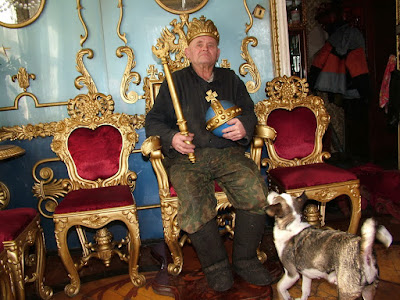 |
this picture and the next two from Russian social media without any referral to the photographer(s) |
In the small community of Klimovo in the Bryansk region of Russia -bordering Ukraine and Belarus- a modest house has been transformed into an art environment with so many baroque adornments that it was referred to as the Palace of the king or as the Bryansk Hermitage.
Life and works
This Palace is the life work of Vladimir Filippovich Akulov (around 1929-around 2012), who only had four years of primary education.
Already as a young boy he felt attracted to wood carving and when he and his mother for some time stayed in Ukraine, he carved small wooden items such as toys, planes and cars, which he sold on the streets to earn a living.
Akulov was conscripted in the military, serving in the Sakhalin area in Russia's far east and after this time in the army he settled in the 1950s in Klimovo, where he got a job in a local cannery.
 |
Akulov's house in Klimovo with woodcarvings on the exterior wall |
Although Akulov in the 1950s and 60s continued making wood carvings and he probably also single handedly constructed furniture for his house, it was in the early 1970s, when he was around age 40, that he seriously began transforming the house into kind of a palace.
In an interview published in 2003 he says that he began when he had seen woodcarving in the neighbouring town Novozybkov. However, in another interview in 2005 he said that one day when he was waiting for a train in the Kiev railway station in Moscow he was struck by the decorations on the walls and the ceiling of the building and felt inspired to do something similar at home.
Maybe both happenings inspired him, the first one may have encouraged him to make wood carvings to decorate the house and the second one to make "baroque" decorations on walls and ceilings.
 |
Akulov in his workshop |
Walls and ceilings of the rooms got decorative elements such as mirrors and paintings which were encased in gilded carvings. The paintings displayed on the walls and ceiling mostly haven't been made by Akulov, but by his father Filippa Artemovicha Akulova or his friend Victor Kurusya.
The furniture included consoles and many distinguished chairs, all richly decorated with gilded carvings.
The most important chair was a smaller copy of the throne of Catherine the Great, crowned with the double-headed eagle, main element of the coat of arms of the Russian Empire, abolished with the 1917 Revolution and restored in 1993 in the coat of arms of the Russian government.
 |
this picture and the next three by Gennady Mikheev |
 |
| floor with inlays (and dogs) |
It is not surprising that some dogs are seen in the picture above, because Akulov would take care of stray dogs, who sometimes stayed in the house with some ten at a time.
 |
| decoration on the exterior wall |
The blue wooden exterior wall of the property was covered with a rider fighting a dragon. The wall also had prancing deer.
 |
| part of the decorations |
In the early years of the 21st century, when the artwork was almost entirely completed, the site got nation wide publicity (see documentation). It became known and attracted visitors both from Russia and other countries.
Although his wife had left him because she didn't like that her husband opened the conjugal home for all types of visitors, due to all interest in his life's work, Akulov may have experienced the years between around 2003 and 2010 as a somewhat glorious period.
In the early 2010s Akulov's health deteriorated. He could no longer take care of the site and it's neglect began.
He died around 2012.
Akulov had a daughter and two sons and one of the sons took up residence in the house. After some years this son sold the property to a couple that renovated the neglected house.
Documentation
* Another review of early date (2005) is: Maria Chernitsyn, article in the journal Moskovsky Komsomolets, no 1515, February 26, 2005
* In 2016 the site got publicity on Russian social media. such as this post on Yaplakal.com, edited as if the artist was still alive
Video
* Video by Russian TV1 Moscow (2'35", July 17, 2007)
Vladimir Filippovich Akulov
Palace
Klimovo, Bryansk region, Russia
actual situation unclear
* Video by Russian TV1 Moscow (2'35", July 17, 2007)
Palace
Klimovo, Bryansk region, Russia
actual situation unclear
Уважаемый Хенк Спасибо! Великолепно!!!
ReplyDeleteThis is incredible! I love seeing the workshop so you can see the actual pieces being made. Your posts on Russian sites are making me want to travel there!
ReplyDeleteIndeed Yessica, it's really exiting to make these discoveries in Russia
ReplyDelete